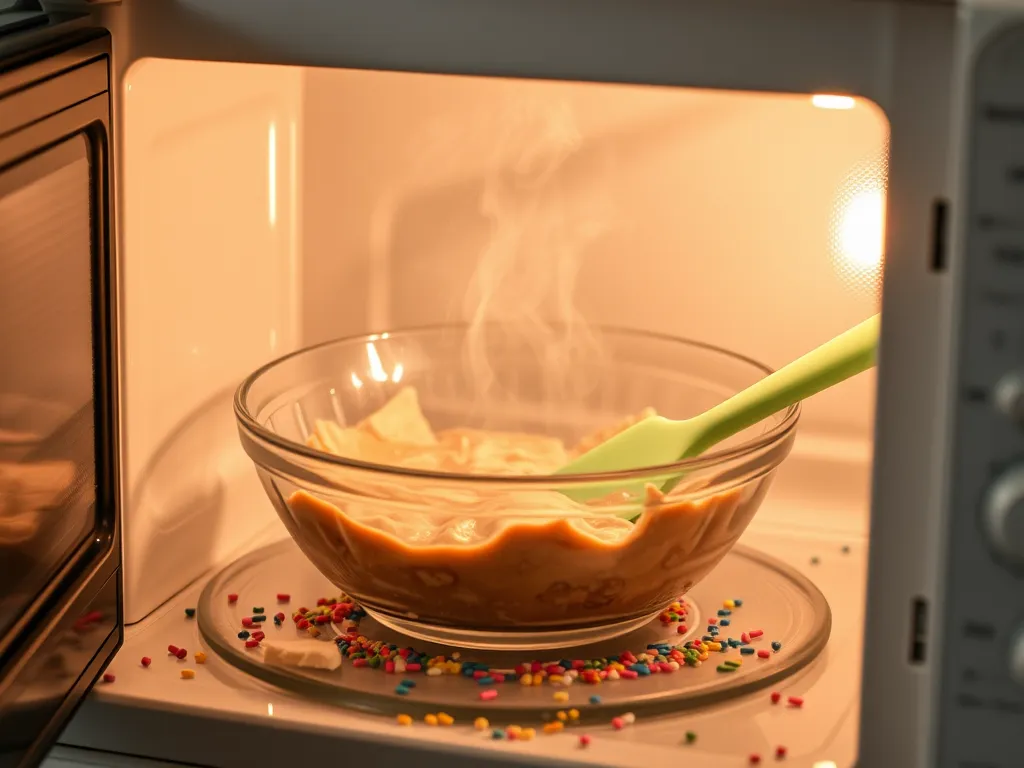Melting almond bark in the microwave is faster than explaining why you’re stress-baking at 11 p.m. Done right, it takes just 90 seconds and requires zero babysitting—no double boiler, no tempering fears, no burnt chocolate disasters.
We’ve got your back: this method delivers smooth, dippable bark every time. No fancy equipment or culinary wizardry needed.
Below, we’ll walk through microwave settings, stir strategies, and how to fix common mishaps (looking at you, grainy texture). Grab a microwave-safe bowl and let’s melt this thing.
Jump To:
How to Melt Almond Bark in the Microwave
Recipe by Lisa MartinCourse: DessertCuisine: American5
5
minutes2
minutes180
kcal7
minutesMelting almond bark in the microwave is a convenient and efficient way to prepare this chocolatey treat for all your baking and candy-making endeavors. Follow these easy steps to melt almond bark perfectly and use it for your favorite recipes, whether for dipping fruits, drizzling on desserts, or coating assorted goodies.
Ingredients
almond bark
microwave-safe bowl.
Directions
- Break the almond bark into smaller pieces and place them in a microwave-safe bowl.
- Microwave the almond bark on high for 30 seconds, then remove it and stir.
- Return the bowl to the microwave and heat for another 30 seconds, then stir again.
- Repeat the heating and stirring process in 15-second increments until the almond bark is completely melted and smooth.
- Be cautious not to overheat, as this can cause the chocolate to seize.
- Once melted, use the almond bark immediately for dipping or drizzling, or allow it to cool slightly before using..
Notes
- For best results, ensure your bowl is dry and clean before adding the almond bark. Stirring between increments is essential to avoid burning the bark. If the melted almond bark thickens, add a teaspoon of vegetable oil to thin it out and achieve a smoother consistency.
What is Almond Bark?
Almond bark is a vanilla-flavored candy coating made with sugar, vegetable fats, and milk solids. Despite the name, it usually contains no almonds—my mom, Linda, once spent 20 minutes scanning a package before realizing it’s just called “almond bark” because it’s traditionally used for coating almonds. Think of it as chocolate’s less finicky cousin: it melts smoothly without tempering and hardens quickly at room temperature.
Available in blocks or pre-chopped chips, almond bark has a higher melting point (around 110°F) than real chocolate due to its vegetable oil base. This makes it forgiving for microwave use—no need to panic if your brother Joseph sneaks a phone call mid-melt. We’ve all been there during picnic prep chaos!
What Does Almond Bark Taste Like?
Imagine white chocolate dialed up to a 9 on the sweetness scale with a creamy vanilla finish. It lacks cocoa butter’s richness, but that’s intentional—its mild flavor pairs well with salty pretzels, tart strawberries, or crunchy nuts. During a lakeside picnic last summer, we drizzled melted almond bark over popcorn, and Joseph declared it “vanilla sunshine in snack form.” For a quick and delicious dessert, try a microwave white chocolate raspberry mug. It’s a simple treat that perfectly combines sweetness and tartness in just minutes.
Pro tip: almond bark’s sweetness mellows slightly when melted, making it ideal for balancing bitter coffee or tangy dried fruit. Just don’t expect dark chocolate complexity—this is the MVP of quick, crowd-pleasing treats. If you’re looking for something equally delightful, a microwave cherry almond mug offers a delicious and easy alternative for a sweet craving. In just a few minutes, you can enjoy a warm, cherry almond treat that pairs perfectly with almond bark’s flavor profile.
Ready to turn those almond bark bricks into liquid gold? Let’s talk ingredients and smart substitutes for when your pantry rebels. For a quick and delicious treat, consider making some microwave cornbread with almond flour. It’s an easy dish hack that transforms simple ingredients into a satisfying meal in minutes.
Ingredients & Substitutes for Melting Almond Bark
Almond bark is our ride-or-die for quick candy coatings, but let’s face it—sometimes we raid the pantry and come up empty. No shame! Candy melts work as a 1:1 swap with identical melting behavior. They even come in rainbow colors for unicorn-themed pretzel rods (ask my niece’s birthday party). For an exciting twist, using a microwave candy recipe can make creating treats even simpler. These quick and fun recipes allow you to whip up delicious candies in no time at all, perfect for parties or just satisfying your sweet tooth.
Out of both? Grab chocolate chips. They’re oilier, so add 1 tsp coconut oil per cup to mimic almond bark’s silky flow. Semi-sweet chips bring bittersweet depth, while white chips keep it mellow. Just avoid sugar-free varieties—they seize up faster than a shy turtle. For a delightful twist, consider making rolo turtles in the microwave. This quick recipe allows you to melt chocolate and caramel effortlessly, creating a perfect treat.
Using Oil, Shortening, or Butter for Smooth Texture
Even almond bark can get clumpy if microwaved too long. For rescue missions, stir in ½ tsp vegetable oil or shortening per 8 oz block. Shortening keeps the flavor neutral, while butter adds a creamy richness—perfect for drizzling over caramel corn. Unlike microwaving butter for popcorn, which can be tricky, melting almond bark requires a gentler touch.
Pro tip: Butter contains water, so use sparingly. Once, I got overzealous and added a full tablespoon. Let’s just say my strawberry dippers turned into strawberry skaters. A little fat goes a long way! For an even more delightful experience, consider creating a spring herb butter spread. This can be effortlessly blended in the microwave, making it a perfect addition to enhance your dishes this season.
Also See: 2-minute Microwave Peanut Butter Fudge – Quick & Easy!
Step-by-step Instructions to Melt Almond Bark in the Microwave
We’ve melted enough almond bark to fill a kiddie pool (metaphorically, Joseph). Follow these steps, and you’ll nail it on the first try. If you’re looking to make your almond milk warm, heating it in the microwave is a quick and easy solution. Just remember to take care to avoid overheating for the best texture and flavor.
Step 1: Chop Almond Bark Into Uniform Pieces
Grab a chef’s knife and slice the bark into ½-inch chunks. Uneven pieces melt at different speeds—ask the charcoal briquette I made last Thanksgiving. Pre-chopped chips? Skip this step and high-five your past self. When it comes to melting chocolate chips, using the microwave can be a quick and effective method. Just remember to heat them in short intervals to prevent burning.
Step 2: Use a Microwave-safe Bowl
Glass or ceramic bowls are MVP here. Plastic warps, and trust me, fishing molten bark out of a floppy container is no one’s idea of fun. Use a 2-quart bowl to prevent overflow during stirring. When making sure your bowl is safe for use, remember that most glass bowls are perfectly microwave-safe, making them ideal for heating up leftovers or preparing quick meals.
Step 3: Microwave at 50% Power in Short Intervals
Full power nukes the edges while the center stays stubbornly solid. Set your microwave to 50% (usually labeled “medium”) and zap for 30 seconds. Then, switch to 15-second bursts. Total melt time? 1.5-2 minutes for 12 oz.
Step 4: Stir Thoroughly Between Intervals
Residual heat does 60% of the work. Stirring redistributes warmth and prevents scorching. Use a silicone spatula—it scrapes every gooey bit off the bowl’s sides. No vigorous whisking needed; gentle folds work best.
Step 5: Adjust Consistency With Additives (if Needed)
Too thick? Add fat ¼ tsp at a time until it ribbons off your spatula. For coconut lovers, swap oil for virgin coconut oil—it adds a tropical twist to vanilla bark. When using coconut oil, melting it in the microwave is a quick and easy option. Just be sure to heat it in short bursts to prevent overheating. Too runny? Let it sit 2 minutes. The cooling firms it up fast.
Also See: Lazy Microwave Frozen Mozzarella Stick Wrap: Quick and Cheesy

Tips for Perfectly Melted Almond Bark
Mastered the basics? These pro moves take your bark from “meh” to Michelin-worthy (if Michelin did candy apples).
Avoid Overheating
Almond bark scorches at 120°F. If your bowl feels hotter than a latte, pause and stir. Burnt bark smells like regret and can’t be saved—unlike my 2020 sourdough phase.
Test Consistency Before Use
Dip a spoon, then tilt it. Ideal bark coats evenly without dripping like a leaky faucet. For drizzling, aim for honey-like flow. Dunking? Make it as thick as Greek yogurt. Adjust with oil or cooling as needed.
Now that your almond bark is velvety smooth, let’s talk storage hacks to keep it that way. Because nobody wants a candy coating that’s harder than calculus.
How to Store Melted or Unused Almond Bark
Leftover almond bark? No problem. Unmelted blocks stay fresh for 6 months in an airtight container at room temperature—just keep them away from sunlight and your oven’s heat vents. My pantry once doubled as a sauna, and let’s just say my bark developed a sugar bloom (those white streaks are harmless but look like frostbite).
For melted leftovers, pour them into silicone molds or a parchment-lined container. Once solidified, wrap tightly and refrigerate up to 2 weeks. Freezing isn’t ideal—condensation during thawing can make your bark as temperamental as my niece’s glitter slime collection.
Reheating Solidified Almond Bark
Reviving hardened almond bark is easier than reviving my will to do dishes. Chop it into bits, microwave at 50% power in 15-second intervals, and stir like you’re persuading a toddler to eat broccoli. If it’s grainy, add 1 tsp coconut oil per cup and stir—this saved my sister’s birthday cake drizzle during a 9 p.m. pantry raid. Speaking of quick and easy treats, consider trying quick microwave almond butter cups for a delicious and satisfying snack.
Reheated bark behaves like new, but avoid multiple melt cycles. Each reheating risks moisture sneaking in, which can cause seizing. Store any re-melted leftovers in the fridge and use within a week. Trust me, future-you will high-five past-you for labeling the container with dates.
Even with perfect storage, almond bark can throw curveballs. Let’s tackle those common mishaps before they tackle your dessert plans.
Now It’s Your Turn to Melt Almond Bark!
We’ve covered everything from chopping techniques to troubleshooting grainy textures—now all that’s left is for you to grab that microwave-safe bowl and start melting. Remember, patience is key; those 30-second intervals and thorough stirring make all the difference between silky smooth and lumpy disaster.
Got any almond bark triumphs (or tragedies)? Share your microwave adventures with us—we love hearing about your kitchen experiments! Whether you’re dipping strawberries or crafting holiday treats, perfectly melted almond bark is just a few beeps away.




